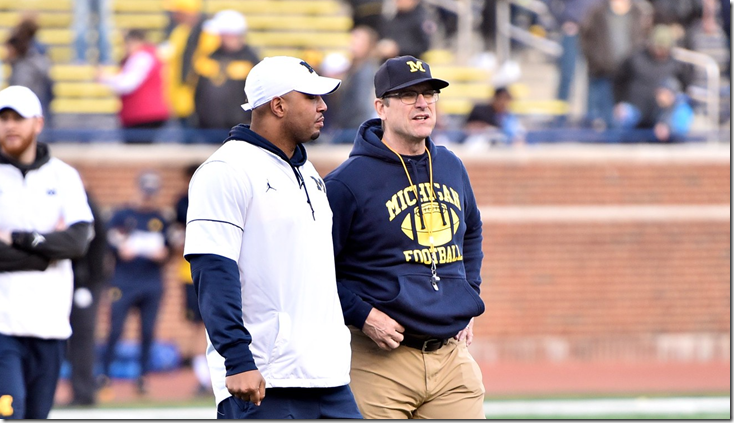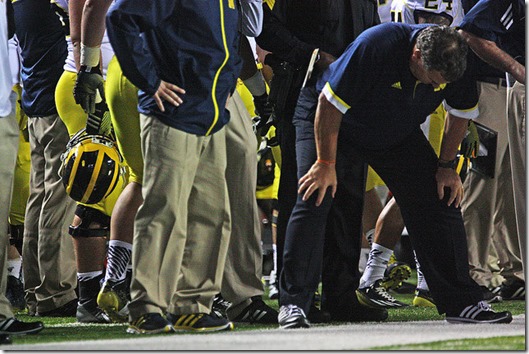offense

Previously in 2021: The Story. Podcast 13.0A. Podcast 13.0B.
Last year: 5Q5A: Offense 2020. Quarterback. Running Back. Wide Receiver. Tight End. Interior OL. Offensive Tackle.
Your productivity is safe; there will be no positional previews this year (see: The Story). Hail to the Victors was finished so late all of that is still good except perhaps [checks Nebraska preview] yep, all of it’s still good. Let’s ask the questions, starting with the saddest, and working our way back to hope.
1. Who’s running the offense?
Somebody’s going to jail. [Bryan Fuller]
It’s Josh Gattis. I’m sure Jim Harbaugh is involved, but the popular fan theory that the old man trapped in Schembechlerian thinking is dictating smashmouthian football hasn’t held up, at least so far. The evidence is all over. They made BEN MASON a tight end, for one. Gattis said he is going to get best athletes the ball in space where they can make plays. The receivers have been running various takes on levels that clear out space underneath for their star wide receiver, who led the league in average YAC.
Michigan's Ronnie Bell is dangerous after the catch pic.twitter.com/JvohoDqzkj
— PFF College (@PFF_College) July 10, 2020
They passed far more often—44% both years—on standard downs than any other year under Harbaugh. Half of those passes went to a slot receiver, and another chunk went to slants off RPOs. The base running attack remained the Buck Sweep, which we’ve been calling Pin & Pull. That has been their thing since the back half of 2018. Screens have remained mostly left out of the offense. This is all pulled from UFR data since 2008:
STANDARD DOWNS, NOT IN COMEBACK MODE
| Era | Pass Rate | Pass Short | Bomb | Power | QB Run | Screens | Dropback% |
|---|---|---|---|---|---|---|---|
| Rodriguez | 23% | 14% | 5% | 6% | 40% | 9% | 56% |
| Hoke | 37% | 17% | 7% | 20% | 16% | 6% | 52% |
| Harbaugh 15-18 | 38% | 17% | 7% | 35% | 4% | 4% | 59% |
| Gattis | 44% | 23% | 10% | 19% | 12% | 5% | 74% |
[QB run includes zone read/arc stff]
Also about 8% of the offense has been RPOs, up from negligible prior. Where Gattis is an outlier is he’s been more likely to have his quarterbacks throw it deep on early downs.
The other interesting thing about Gattis on early downs is he doesn’t use much play-action, something we have tracked consistently across eras. Sometimes there’s a tiny wave of the ball at an RB going by—that doesn’t count as PA in our charting (and gets the old guys on Twitter furious).
When Gattis is able to run his offense, his offense passes more, and drops back more. It still doesn’t screen, but it’s substantially different than the “Harbaugh”-called offenses under Drevno/Pep/The Cast of Too Many Cooks. What he does so much differently than Pep Hamilton is create space to throw to the guy who can pick up extra.
Pep’s overarching philosophy for his routes—I believe— was in creating levels reads that pop open one after another. Gattis is the contrast: look how the targets are spaced out in the four corners of the field, drawing defenders until there’s just one to read. He steps deep with the WR who ran right at him, and the underneath is thrown.
It might just be that the reads-on-everything, defenders getting pulled in multiple directions, QB run threats, RB wheels, and bombs we hoped Gattis imbibed from Joe Moorhead did not take, or that they did but are muted by the paralyzing conservatism of James Franklin.
The thing I can’t show in the charts is there has been a lot more of the Mike Locksley/get people moving across the backfield stuff. It’s mostly been a dud. The kings of that kind of football right now are the Baltimore Ravens, and Matt Weiss was supposedly a big part of that design. They run jets and orbits and then have the receivers kick out or turn into wheels. Gattis has mostly used those guys as flare routes or fake pitch options—the football equivalent of putting a Just a Shooter™ in the corner to increase spacing. Because the Michigan offense ignores that guy out there, so has the defense.
Ideally this year the presence of Weiss and the co-coordinator role for Sherrone Moore give Gattis a sharper edge. They CANNOT slip back into this “we’re reading nobody” idiocy that we saw again last year after it was banished post-Notre Dame 2018. I wish I could blame that on Harbaugh.
[After THE JUMP: Make sense please.]
No, Upon Further Review series is not comprehensive. Most years are absent Ohio State and bowl games (including last year), and 2014 checked out after Indiana. That said, I challenge you to find a greater cache of free data than Brian's masterful charting of Michigan plays going back to the DeBord Throws Rock age.
Every so often I pull all that into a massive Excel file and try to learn things like how spread the offense was, favorite plays, etc. Let's dive in shall we?
What're those pie charts at top? Shows the relative efficiency (by yards per play on standard downs) and the mixes of Michigan's backfield formation choices. For "standard downs" I mean 1st and 2nd downs when the offense wasn't trying to do a clock thing or go a super-long or super-short distance. So no garbage time, no two-minute drills, no goal line, and no going off on Bowling Green and Delaware State. The idea is to show which offense did they get in when they had the full gamut to choose from, and how many yards did it get when the goal presumably was to get as many yards as possible.
Nothing very surprising there. Rodriguez ran his shotgun offense, Borges inherited Denard and Devin and still managed to jam them half-way into an under-center offense in three years. Then Nussmeier ran his zone melange single-back thing. Harbaugh did what Hoke always dreamed of doing, and the offense climbed back to about where Hoke's offense was with a senior (but oft injured) Denard.
---------------------------------
[Hit THE JUMP for each year's most charted play, visualized Hennecharts, how many TEs Harbaugh used, how many rushers defenses sent, and LOOOOOTS of charts.]
[Adam Glanzman]
“Sometimes, there's a man, well, he's the man for his time and place. He fits right in there. And that's the Dude, in Los Angeles… But sometimes there's a man, sometimes, there's a man. Aw. I lost my train of thought here. But... aw, hell. I've done introduced him enough.” –The Stranger, The Big Lebowski
In mid-2010 I got hired by a bank to be a Customer Service Representative teller. This put me on the front lines of the never-ending war between people’s money and the financial organizations that hold it. I learned very quickly that there were two things that could turn a mild-mannered citizen into a venom-spewing troglodyte: bank fees and Rich Rodriguez.
I loved when people came into the bank wearing college gear because it meant I’d be able to easily strike up a conversation about football, and people are a little less likely to verbally assault you when you’re able to find some common ground. The operative word in that last sentence is “little,” but I digress. By the fall of 2010 people were so fixated on the abject disaster that was Michigan’s defense that they willfully ignored how incredible the offense was. This was the fuel they needed to turn the “RichRod isn’t a ‘Michigan Man’” fire into a raging inferno, and it got so out of control that I talked to people who were even criticizing Rodriguez’s wife for not being Michigan-y or Michigan-ish or something crazy like that. At one point someone complained to me about her having blonde hair.
The Microscope of Public Scrutiny was so zoomed in on Rodriguez and everything surrounding him that Dave Brandon was able to make the Free Press look stupid and then lie in wait. At some point in 2010 Brandon’s opinion aligned with the bank’s clients; to them, the Rodriguez experiment had failed. Enter: Brady Hoke.
Hoke represented everything that the anti-Rodriguez movement wanted: familiarity with the program, a defensive background, and the mixture of self-oriented humility manifest in his claim that he’d walk across the country for the job and the program-oriented bravado in the interminable fergodsakes claim.
The honeymoon phase lasted a full season, but by the end of Hoke’s fourth year the program was in a place similar to where he found it, a place all too familiar to Michigan’s fanbase. One side of the ball was above average, but the other side was in such shambles that the team collapsed under the dead weight.
**********
"Once we get the power play down, then we'll go to the next phase. You know, because we're gonna run the power play."
Brady Hoke, 3/23/2011
The transition from Rich Rodriguez to Brady Hoke was like switching from cold brewed coffee to run-of-the-mill drip coffee; a move away from the newer, higher-octane movement and toward what felt more traditional, the tried and true. The fallout from this was immediately apparent in the speculation that one of the most dynamic players to every don the winged helmet might transfer to a school with an offense better suited to his talents (i.e. a school that wouldn’t put him under center and have him hand the ball off).
In what may be one of the most significant events in program history (more on that later), Denard stayed. Al Borges still tried to put Denard under center and Michigan did rep power, but there were enough zone reads incorporated to allow Denard to continue waking up opposing defensive coordinators in cold sweats. You know all of this. You watched it unfold. That also means you watched crimes perpetrated against manpanda and an offense hell-bent on skinning its forehead running against a brick wall before finally, mercifully, abandoning their MANBALL-big-boy-football-noises ideals and exploding out of the shotgun.
This piece is intended to be the counterpoint to the memory’s emphasis on the spectacular. The intent isn’t to accuse, but to take a more calculated look at what exactly happened to Michigan’s offense over the last four years and see where things went well, as well as where and how things stopped functioning.
[After THE JUMP: charts and tables]



136